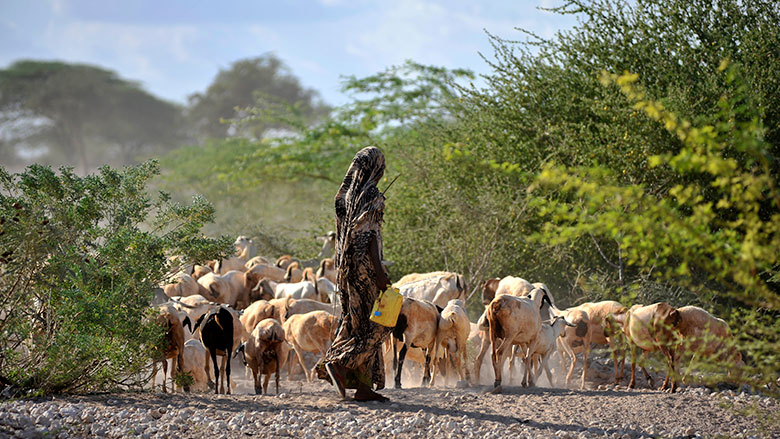WASHINGTON, May 19, 2020 – While the Horn of Africa’s borderland communities have historically been politically neglected, a new World Bank report says policies for these regions can create pathways to socio-economic progression.
The report, “From Isolation to Integration: An Overview of the Borderlands of the Horn of Africa,” says the Horn of Africa countries - Djibouti, Eritrea, Ethiopia, Kenya, Sudan, South Sudan, Somalia and Uganda - include some of the region’s fastest growing economies, but the same cannot be said for the communities living around the countries’ borders. Despite a history of marginalization, as well as environmental degradation, forced displacement, grinding poverty and underdevelopment, the report says there are several areas in the borderlands with real economic potential even as they face the most current threat; COVID-19 (coronavirus).
“Today, Africa has over 100 active border disputes whose causes include the politics of identity, competition over natural resources, population growth and displacement and environmental pressures,” said Dr. Workneh Gebeyehu, Executive Secretary of the Intergovernmental Authority on Development (IGAD). “The COVID-19 pandemic has further compounded the vulnerability of marginalized communities in the face of emergencies particularly along the borderlands of Somalia, Kenya, Ethiopia and Djibouti. Our efforts jointly with IGAD Member States, have focused on protecting vulnerable communities from the infection and spread of the coronavirus and cushioning the informal economy upon which borderland communities depend for their livelihoods.”
The World Bank report reiterates that understanding of context and history is key to crafting better targeted policies for these regions that can then present pathways to socio-economic progression for residents. The report focuses on two border regions – Karamoja region (southeastern Sudan, southwestern Ethiopia, northwestern Kenya, and northeastern Uganda) and the Mandera triangle, formerly known as Somali region (northeastern Kenya, southeastern Ethiopia, and Southern Somalia).
The preeminent challenge for the borderlands regions is the harsh weather and terrain. These regions are characterized by semi-arid lands and perennial water shortages and are mostly inhabited by agro-pastoralists who depend on a combination of nomadic livestock-keeping and subsistence farming for survival. Mobility is central to their livelihoods, and they often cross-country boundaries in search of pastures, water and markets. This nomadic lifestyle has been a source of conflict over scarce resources (such as water and rangelands).
The region has also witnessed violent extremism, including from al-Shabaab. Several nations have responded to the insecurity by tightening border controls, inadvertently blocking smalltime border traders and cutting off their source of livelihoods. As a result, some households have been pushed towards less sustainable alternatives like burning trees to prepare charcoal, contraband trade and banditry. Lack of options amid depletion of natural resources, cross-border chokeholds and a population surge has also driven youths to urban centers, denying these regions energetic talent.
There are, however, several encouraging developments toward legalization of informal cross-border trade, identified by the report. Ethiopia, for example, has a bilateral agreement with Sudan, allowing traders to make 48 trips per year with goods valued up to $117 per trip, same with Djibouti, Kenya, and Somalia.
“Given the various drivers of fragility in the Horn of Africa—including high levels of poverty, environmental degradation, weak formal and informal institutions, conflict and forced displacement—there is an urgent need to invest in the systemic resilience of the region and importantly the borderlands, to enhance their capacities to prepare for and respond effectively to shocks and stresses, and to achieve development goals., said Varalakshmi Vemuru, World Bank Lead Social Development Specialist, and lead author of the report.
The report further suggests four approaches to ensure sustainable development across the Horn of Africa’s borderlands:
- Regional collaboration at the policy and institutional levels: Pursue collaborative efforts to ease cross-border flow of capital, labor, goods and services.
- Investment in basic infrastructure and social services: Basic hardware and social services should be rolled out to open up the borderlands and improve welfare, including roads, energy, education, health, water, ICT, and access to finance.
- Strengthening of local community institutions: Given that these areas suffer from weak governance and frequent skirmishes, there is a risk that investments cannot be sustained. Therefore, local institutions should be strengthened to boost collaborative border management and capacity for conflict management.
- Human capacity building: As a targeted intervention, locals should be equipped with modern skills through training, participatory education and microfinancing. Also, women should be empowered to enable households improve the quality of their lives and accumulate wealth.
With recent discovery of strategic resources—including water, oil, gas, gold, potash, and aquifer—the report recognizes the borderlands as emerging economic centers The report notes that using these resources through the inclusion of marginalized communities could accelerate turnaround of their fortunes. With population growth of 3% each year expected to double every 23 years, the report notes that there is an opportunity for policy makers to prioritize borderlands and the communities that live within them to fast track economic growth by reconsidering perspectives on the interplay between conflict, development and nation building.
